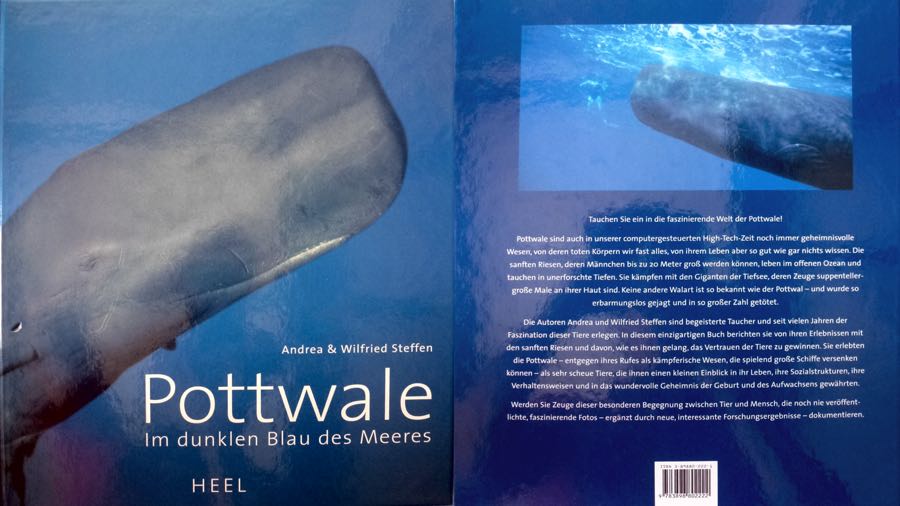
Sperm whales – in the dark blue of the sea
Excerpt from our chapter: A matter of taste
The tongue
It takes many months for the young to learn from their mother to hunt sufficient quantities of prey. As long as she will continue to suckle him, even if he has already hunted one or two fish himself. If he is successful, they are swallowed whole without chewing.
Squid and even whole sharks have been found unchewed in the stomachs of adult sperm whales that have been killed. The teeth of all toothed whales are purely catch teeth and are not suitable for chewing. The muscles are also developed accordingly. The muscles responsible for chewing movements are only present as remnants, while the sphincters of the mouth have become very strong and can be clearly seen.
With the lower jaw folded down, which reaches an opening angle of up to 90°, the sperm whales can literally suck in the prey with powerful movements of their tongue. When studying sperm tongues, Alexander Werth of the Hampden-Sydney Collage in Virginia found that powerful muscles are attached to the jaw, which enable the short, flat tongue to move quickly back and forth. The resulting negative pressure transports the prey directly into the throat.
Further targeted studies by Günther Behrmann have shown that the tongue of sperm whales is very mobile and the inner part consists of three muscles. These muscles are covered by a erectile tissue, which can be changed in size by the blood system.
The taste
Because no taste buds were found in previous studies, the whales were assumed to lack a sense of taste. It was only when dolphins preferred certain fish when feeding in dolphinariums that people started looking for taste buds. Because these are not located on the tongue like in humans, but on papillae that line the edge of the tongue, they were only discovered very late.
Their sense of taste was retained, but their sense of smell was greatly reduced.
The smell
But what significance do smelling and tasting have underwater?
Smelling is the detection of chemical substances distributed in the air that come from distant sources. Tasting, on the other hand, means recognizing chemical substances that are dissolved in liquid and brought into contact with the mouth. Both senses are therefore based on chemical stimulation. In the water, it is not possible for whales to distinguish between smelling and tasting because they keep their nose, the blowhole, constantly closed underwater. The blowhole only opens when they are on the surface to breathe. But inhaling happens so quickly that smelling would only be of very limited use.
The olfactory nerve is severely degenerated in all whales. The researchers concluded that whales cannot smell. Therefore, it was not considered necessary to further examine the olfactory zones.
Despite this, Günther Behrmann discovered through detailed examinations that the whales have completely regressed their olfactory nerve leading to the brain, but have retained their olfactory fields in their noses and the olfactory cells are still fully functional.
These olfactory cells have an elongated shape and all have a sensory hair that has many pores (chemoreceptors) that are connected to the brain via the trigeminal nerve. But even if the olfactory cells are still fully functional, that does not mean that whales can smell. This condition can be compared to a person whose olfactory nerve has been severed. His olfactory cells are still fully developed, but he can no longer perceive smells.
Smelling is therefore unsuitable for whales to eat; instead, the whale uses its more pronounced sense of taste. However, this not only serves it to acquire food, but also to locate a partner who is willing to mate. When a female is ready to mate, she sends out scents that are picked up by the male through his sense of taste.
The sexual substances are thus “tasted” by the whales.
The receptors
During his research work, Günther Behrmann also discovered that the skin of the highly sensitive tongue not only contains taste buds, but also many nerve endings that have previously only been found in ducks and woodpeckers. He is convinced that the tongue also serves as a tactile organ for the whale.
Furthermore, electroreceptors were found on the tongue that are otherwise only known from the lateral line organs of fish and the ampullae of Lorenzin on the head of sharks. With these receptors the animals can perceive electrical and magnetic waves.
I was able to observe the demonstration of these abilities myself in 1977. I took part as a safety diver in the filming of a Hessischer Rundfunk television documentary about sharks. To demonstrate the ability to perceive, Sigurd Tesche and his film team, under the instructions of the responsible editor Joachim Bublath, prepared a container that emitted weak electrical impulses.
The first sharks had already arrived, curiously circling the container. Soon there were more than a dozen sharks that repeatedly attacked this container by nudging it with their mouths, even though it contained neither fish nor blood.
In 1986, the English whale researcher Professor Klinowska discovered that strandings were more common in places where geomagnetic anomalies occurred. This also makes it possible to demonstrate a connection between the detected electroreceptors on the tongue and the registration of geomagnetic waves.
Swallowing
Here too, Günther Behrmann discovered another deviation in the sperm whale from all other whales. His laryngeal tube is too short to reach directly into the nasal arena. However, it is additionally protected by a ring muscle, which instead prevents water from penetrating.
The stomach
The intestines
The drink
Since they have no way of taking in fresh water, they cover their fluid needs through food. The fish they eat have a salt content that is two-thirds lower than sea water and their body water can therefore be processed better in the sperm whale's kidneys. Whales that do not eat for months meet their fluid needs from their layer of blubber, the so-called blubber. Whale babies, which are still being nursed exclusively and cannot yet eat fish, get the fresh water they need through their mother's milk.
Even though breast milk consists of 50% fat and is thick like creme fraiche, it contains almost no sugar. When the baby whales consume their mother's milk and the fat is broken down in their bodies, water is created as an essential byproduct. In this way, the babies drink without depriving the mother of a lot of water.
The kidneys

The water is now “processed” by the whale and finally reaches the kidneys. There it is partially returned to the blood with the substances dissolved in it (such as glucose) and the remaining water with the remaining dissolved substances, such as mineral salts and urea, then forms urine. This is considerably more concentrated than in humans. However, urine is also of different importance for some whale species.
The uric acid crystals in the urine are stored in the skin and are therefore the basis of the radiant white skin color, such as that of beluga whales or the flanks of killer whales.
Whale kidneys are actually made up of a large number of small kidneys. This arrangement increases their surface area, which enables the whales to clean larger amounts of blood. Each small kidney is therefore an independent organ. The size of the entire sperm whale kidney varies from 50 x 25 cm to a length of 120 cm. The weight is 12 kg for smaller sperm whales and up to 20 kg for larger animals.




 Die Autoren Andrea und Wilfried Steffen sind begeisterte Taucher und seit vielen Jahren der Faszination dieser Tiere erlegen. In diesem einzigartigen Buch berichten sie von Ihren Erlebnissen mit den sanften Riesen und davon, wie es ihnen gelang, das Vertrauen der Tiere zu gewinnen. Sie erlebten die Pottwale – entgegen ihres Rufes als kämpferische Wesen, die spielend große Schiffe versenken können- als scheue Tiere, die ihnen einen kleinen Einblick in ihr Leben, ihre Sozialstrukturen, ihre Verhaltensweisen und in das wundervolle Geheimnis der Geburt und des Aufwachsen gewährten.
Die Autoren Andrea und Wilfried Steffen sind begeisterte Taucher und seit vielen Jahren der Faszination dieser Tiere erlegen. In diesem einzigartigen Buch berichten sie von Ihren Erlebnissen mit den sanften Riesen und davon, wie es ihnen gelang, das Vertrauen der Tiere zu gewinnen. Sie erlebten die Pottwale – entgegen ihres Rufes als kämpferische Wesen, die spielend große Schiffe versenken können- als scheue Tiere, die ihnen einen kleinen Einblick in ihr Leben, ihre Sozialstrukturen, ihre Verhaltensweisen und in das wundervolle Geheimnis der Geburt und des Aufwachsen gewährten.
 Werden Sie Zeuge dieser besonderen Begegnung zwischen Tier und Mensch, dokumentiert mit noch nie veröffentlichten, faszinierenden Fotos und ergänzt durch neue, interessante Forschungsergebnisse.
Werden Sie Zeuge dieser besonderen Begegnung zwischen Tier und Mensch, dokumentiert mit noch nie veröffentlichten, faszinierenden Fotos und ergänzt durch neue, interessante Forschungsergebnisse.
 Spannend und einfühlsam lassen sie die Leser an ihren hautnahen Walbegegnungen teilnehmen. Mit einmaligen Aufnahmen, vor allem von den drei Großen: den Blau-, Buckel- und Pottwalen, belegen sie ihre in weltweiten Beobachtungen gesammelten Erkenntnisse. Einzigartig ihre jahrelange Begleitung der „Group of Seven“, einer Gruppe von Pottwalen, den größten Raubtieren der Erde, bei der sie das Heranreifen eines Jungbullen von der Geburt an erleben konnten.
Spannend und einfühlsam lassen sie die Leser an ihren hautnahen Walbegegnungen teilnehmen. Mit einmaligen Aufnahmen, vor allem von den drei Großen: den Blau-, Buckel- und Pottwalen, belegen sie ihre in weltweiten Beobachtungen gesammelten Erkenntnisse. Einzigartig ihre jahrelange Begleitung der „Group of Seven“, einer Gruppe von Pottwalen, den größten Raubtieren der Erde, bei der sie das Heranreifen eines Jungbullen von der Geburt an erleben konnten.
 Tauchen Sie ein in die Welt der Wale. Erleben sie Großaufnahmen aus allernächster Nähe und erfahren sie interessante Forschungsergebnisse aus dem geheimnisvollen Leben dieser Meeresriesen.
Tauchen Sie ein in die Welt der Wale. Erleben sie Großaufnahmen aus allernächster Nähe und erfahren sie interessante Forschungsergebnisse aus dem geheimnisvollen Leben dieser Meeresriesen.